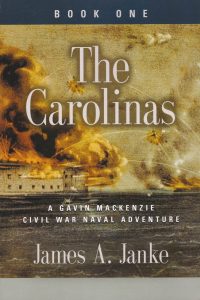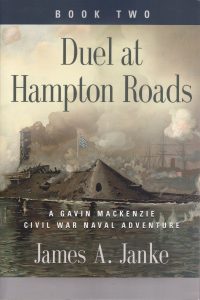Naval Battles
Union naval action against the Confederacy was often joint operations against shore facilities. The Union Army and Navy worked well together during the Civil War. But there were ship-to-ship engagements, some quite famous.
- Battle of Aquia Creek, May 29 to June 1, 1861. The Pawnee, with Gavin MacKenzie aboard, along with two Union gunboats attacked Confederate batteries at Aquia Creek on the Potomac River in Virginia.
- Battle of Aquia Creek, Fredericksburg.com
- Battle of Hatteras Inlet, August 28-29, 1861. Hatteras Inlet in the Outer Banks of North Carolina was the gateway to Pamlico Sound in eastern NC. Capture of Forts Clark and Hatteras gave Gen. Burnside access to that sound as well as sound farther north and Roanoke Island. I cover this battle in detail in The Carolinas.
- Battle of Hatteras Inlet, National Park Service
- Battle of Hatteras Inlet, Carolina Country
- Battle of Roanoke Island, February 7-8, 1862. Part of General Burnside’s invasion of eastern North Carolina. Roanoke Island was the plug between Pamlico Sound and Albemarle Sound in eastern North Carolina. Control of the Sounds gave the Union fleet access to numerous rivers emptying into the Sounds. This battle is featured prominently in my Civil War novel The Carolinas.
- Battle of Roanoke Island,
- Battle of Roanoke Island, Island Life NC
- Battle of Elizabeth City, NC. Fought on the Albemarle Sound and mainly in the Pasquotank River on the February 10, 1862 in the immediate aftermath of the Battle of Roanoke Island. Union and Confederate ships engaged in a fleet action that quickly vanquished the Rebel “mosquito fleet.” Elizabeth City was occupied. Read The Carolinas for details.
- Battle of Elizabeth City, Encyclopedia of North Carolina
- Battle of Hampton Roads, March 8-9, 1862. On March 8 the new Confederate ironclad CSS Virginia, formerly the USS Merrimack, utterly destroyed the wooden sailing warships USS Congress and USS Cumberland. On March 9 the Virginia and the new Union ironclad USS Monitor pounded each other inconclusively for four hours. These two days of battle demonstrated that all the world’s wooden navies were suddenly obsolete. The battle revolutionized naval warfare. You will learn a lot about the Cumberland by accompanying Gavin MacKenzie as he joins the ship shortly before her demise at the hands of the Virginia. And then learn about the Monitor as he joins Lt. Greene in the turret of the ship as the two ironclad giants fight to a draw. Read Duel at Hampton Roads.
- Battle of Hampton Roads, Britttanica
- .
- Battle of Fort Donelson, February 11-16, 1862. The capture opened the Cumberland River to a river invasion of the South by Union forces. The battle that earned Grant his nickname of “Unconditional Surrender Grant”.
- My YouTube Video: Fort Donelson and Grant’s western Tennessee strategy“
- Capture of Fort Pulaski, Georgia. Union batteries pounded this huge brick fort into submission without assaulting it with troops. The capture proved that brick forts were now obsolete; they could not resist repeated bombardment by accurate long-range artillery.
- My YouTube Video: Fort Pulaski, GA and its capture in the Civil War
- Battle of the USS Kearsarge versus the CSS Alabama.
- Battle of Cherbourg, 1864 Another name for the famous engagement between the Union warship and the famous Confederate raider. The Alabama was sunk but her captain, Raphael Semmes, escaped capture.
- Battle of Fort Henry, Tennessee River, February 6, 1862. The Confederate fort was meant to be attacked by a joint force of Union gunboats and Grant’s small army. But the Union gunboats were so effective and Fort Henry so ineffective that the fort surrendered before the Army troops arrived.
- First Battle of Fort Fisher, December 23-27, 1864. Fort Fisher, the “Gibraltar of the Confederacy” guarded access to Wilmington, North Carolina on the Cape Fear River. The assault by Union Army and the Navy fleet failed.
- Second Battle of Fort Fisher, January 13-15, 1865. The second assault was successful, and it closed off Wilmington, the last remaining major port for blockade runners to use.
- Battle of Mobile Bay, August 5, 1864. Farragut attacked Mobile Bay. “Damn the torpedoes! Full steam ahead!”
- Capture of New Orleans, April 25- May 1, 1862. Farragut successfully ran his ocean-going fleet past the formidable Forts Jackson and St. Philip below the city in a daring, spectacular nighttime running of the gauntlet. New Orleans lay helpless under his naval guns and was soon occupied by Union troops.
- Battle of Wassaw Sound, coast of Atlantic Ocean, Georgia, June 17, 1863. The CSS Atlanta, an ironclad upon which much hope was placed, was challenged by the USS Weehawken and USS Nahant on the Confederate ship’s first sortie. The Atlanta ran aground, and the 11-inch and 15-inch Dahlgren cannons of the Weekhawken proved more than a match for the armor of the Atlanta, and the latter surrendered after just a few minutes.
- Sinking of the USS Housatonic, The Confederate submarine CSS H.L.Hunley sank the Union warship on February 17, 1864 near Charleston, SC. But the Hunley and her crew were lost too.
- Hunley Museum, North Charleston, SC. The Hunley was recovered and its conservation can be observed.
- Battle of Head of Passes, Mississippi Delta, October 12, 1861. A small Confederate naval force including the innovative ironclad ram CSS Manassas drove off the much more powerful Union blockading squadron in an embarrassing rout for the Union.
- Battle of Drewry’s Bluff, May 15, 1862. James River, just seven miles from Richmond. A Union fleet of four ships, including the new ironclad USS Galena and the much vaunted USS Monitor, was repulsed by cannon fire from Fort Darling on the bluff, the last chance to stop the Union fleet from reaching the Confederate capital. In the process the Galena was demonstrated to be “not shot-proof”. She suffered two dozen casualties and was hit 45 times with many projectiles penetrating her armor.


